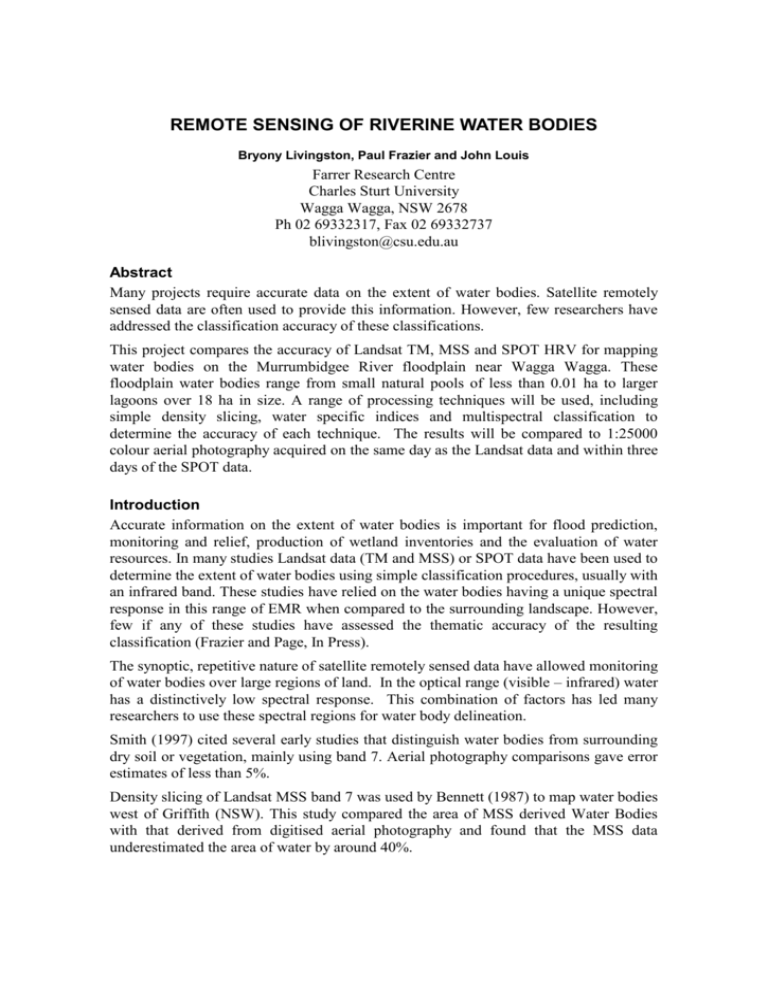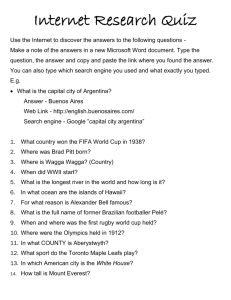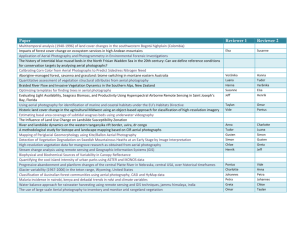10arspc_paper102_00
advertisement

REMOTE SENSING OF RIVERINE WATER BODIES Bryony Livingston, Paul Frazier and John Louis Farrer Research Centre Charles Sturt University Wagga Wagga, NSW 2678 Ph 02 69332317, Fax 02 69332737 blivingston@csu.edu.au Abstract Many projects require accurate data on the extent of water bodies. Satellite remotely sensed data are often used to provide this information. However, few researchers have addressed the classification accuracy of these classifications. This project compares the accuracy of Landsat TM, MSS and SPOT HRV for mapping water bodies on the Murrumbidgee River floodplain near Wagga Wagga. These floodplain water bodies range from small natural pools of less than 0.01 ha to larger lagoons over 18 ha in size. A range of processing techniques will be used, including simple density slicing, water specific indices and multispectral classification to determine the accuracy of each technique. The results will be compared to 1:25000 colour aerial photography acquired on the same day as the Landsat data and within three days of the SPOT data. Introduction Accurate information on the extent of water bodies is important for flood prediction, monitoring and relief, production of wetland inventories and the evaluation of water resources. In many studies Landsat data (TM and MSS) or SPOT data have been used to determine the extent of water bodies using simple classification procedures, usually with an infrared band. These studies have relied on the water bodies having a unique spectral response in this range of EMR when compared to the surrounding landscape. However, few if any of these studies have assessed the thematic accuracy of the resulting classification (Frazier and Page, In Press). The synoptic, repetitive nature of satellite remotely sensed data have allowed monitoring of water bodies over large regions of land. In the optical range (visible – infrared) water has a distinctively low spectral response. This combination of factors has led many researchers to use these spectral regions for water body delineation. Smith (1997) cited several early studies that distinguish water bodies from surrounding dry soil or vegetation, mainly using band 7. Aerial photography comparisons gave error estimates of less than 5%. Density slicing of Landsat MSS band 7 was used by Bennett (1987) to map water bodies west of Griffith (NSW). This study compared the area of MSS derived Water Bodies with that derived from digitised aerial photography and found that the MSS data underestimated the area of water by around 40%. An evaluation of the effectiveness of Landsat TM imagery for mapping lake/pond wetland extent in western Victoria and riverine wetland extent in central Victoria was carried out by Johnston and Barson (1993). Satellite information was compared to manually mapped ground truth. They found that simple density slicing of the TM5 (mid infrared) successfully detected the lake/pond wetland areas. A classification accuracy of 95% was achieved, however this technique failed to map the riverine wetlands adequately. This failure was attributed the narrow width of the billabongs and poor timing of data selection. Frazier & Page (In Press) also used Landsat TM data to detect and delineate water bodies. This study compared the accuracy of single band density slicing with multispectral maximum likelihood classification for water body delineation. They found that the data were capable of accurately mapping riverine water bodies greater than 3 hectares in size. With density slicing of the mid-infrared (Band 5) giving comparable results to the maximum likelihood classification. Aim This project aims to compare the accuracy of using SPOT HRV, Landsat TM and Landsat MSS data for mapping river floodplain water bodies. In addition to comparing the spectral and spatial resolution of these sensors, various image processing techniques will also be compared including: simple density slicing; multispectral classification; and water specific thresholds. Study Area The study area includes the Murrumbidgee River and floodplain near the city of Wagga Wagga, Australia (Figure 1). This river forms part of the Murray-Darling basin and drains an area of approximately 82 000km2 (Olive et al., 1994). The section of the river included in the study is large and meandering with an average bankfull channel width of 80m, a mean depth of 6 metres, a sinuosity of 2.3 and has a predominately suspended load (Page, 1988). Figure 1: The Location of: (A) the city of Wagga Wagga, (B) the Murrumbidgee River within the southern Murray-Darling Basin and (C) the study reach near Wagga Wagga (Frazier and Page, In Press). The river floodplain is 1-2 km wide (Olive et al., 1994) and consists of 6-7m of mud and sand overlying basal gravels. The floodplain contains several types of natural water bodies including lagoons (meander cut-offs or ox-bow lakes), interscroll swales and backswamp depressions. The lagoons are large, many greater than 6 hectares with a similar width to the active channel and varying turbidity and depth. The interscroll swales are smaller waterbodies, most are less than 10m wide and usually hold water only for short periods after floods or heavy rain. Backswamps are shallow depressions that hold water for longer periods and are uncommon in the study reach. There are also several artificial dams in the area. The largest of these is the effluent storage pond for the Wagga Wagga sewerage works (Figure 2). Figure 2: Aerial photograph of the Wagga Wagga region (print 146) showing water body types. Materials Colour aerial photography captured on the 26/10/90 by the NSW Central Mapping Authority, with a nominal scale of 1:25000 will be used as ground truth. Several optical satellite images will be compared to the aerial photography including: Landsat TM (path/row 92/84) captured on the 26/10/90; Landsat MSS (path/row 92/84) captured on the 26/10/90; SPOT HRV (path/row 382/420) captured on the 23/10/90. Proposed Methods The aerial photography will be scanned into a digital format. These data will then be carefully registered to each of the satellite images. Water bodies will be mapped using magnified stereoscopic examination of the hardcopy aerial photographs. The mapped extent of water bodies will then be transferred on to the digital aerial photographs as vector polygons, allowing overlay of the aerial photography water body extent with each of the satellite images. Each of the satellite images will undergo density slicing, multi-spectral classification and transformation by a number of water specific indices. The thematic water layer produced by each of these methods will then be compared on a per pixel basis with the manually mapped aerial photography. This per pixel comparison will allow the generation of error matrices quantifying the accuracy of each technique as it applies to each image type. Expected Results This project will result in a detailed comparison of the accuracy of using Landsat TM, Landsat MSS and SPOT HRV data to map riverine water bodies. In examining classification accuracy, the effects of both sensor resolution (spatial as well as spectral) and image processing technique will be considered. The end result can be visualised as a matrix of sensor types versus the list of image processing techniques, allowing direct comparison of not only the sensor resolution but also the processing method (Table 1). Table 1: Summary table of the accuracy of each technique when applied to imagery from each sensor. Image processing technique Density Slice Satellite SPOT sensor MSS Classification Ratio TM References Bennett, M.W.A., 1987. Rapid monitoring of wetland water status using density slicing, Proceedings of the 4th Australasian remote sensing conference, Adelaide, pp. 682-691. Frazier, P. and Page, K., (In Press). Water body detection and delineation with Landsat TM data. Photogrammetric Engineering and Remote Sensing. Johnston, R., and M. Barson, 1993. Remote sensing of Australian wetlands: An evaluation of Landsat TM data for inventory and classification, Australian Journal of Marine and Freshwater Research, 44:235-252. Olive, L.J., Olley, J.M., A.S. Murray, and P.J Wallbrink, 1994. Spatial variation in suspended sediment transport in the Murrumbidgee River, New South Wales, Australia, Variation in stream erosion and sediment transport, (L.J. Olive, R.J. Loughran, and J.A. Kesby, editors), International Association of Hydrological Sciences Publication 224, pp. 241-249. Page, K.J., 1988. Bankfull discharge frequency for the Murrumbidgee River, New South Wales, Fluvial Geomorphology of Australia. (R.F. Warner, editor), Academic Press, Sydney, pp. 267-281. Smith, L.C., 1997. Satellite remote sensing of river inundation area, stage, and discharge: A review, Hydrological Processes, 11:1427-1439.









